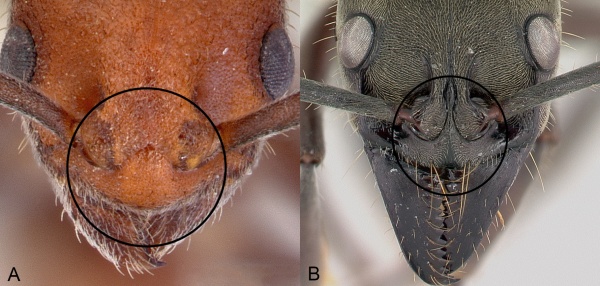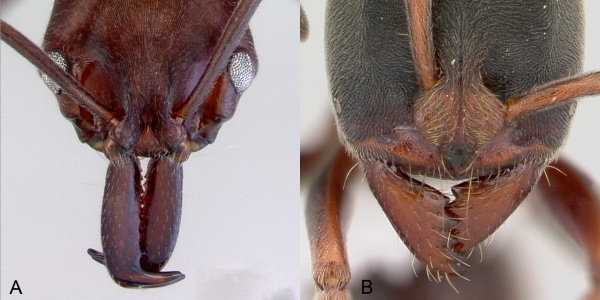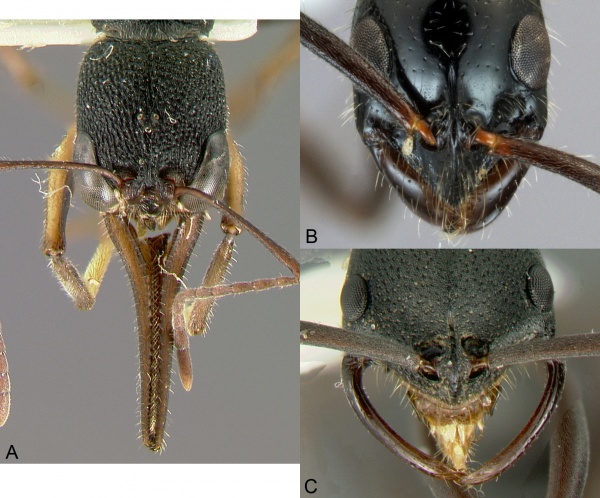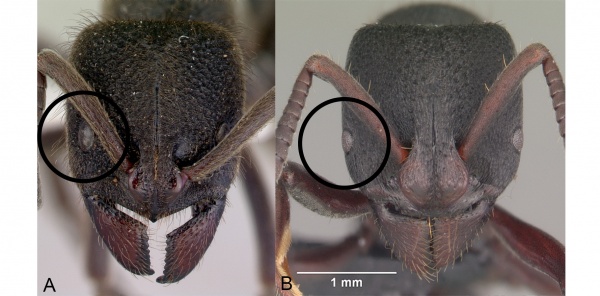Key to Eurasian and Australian Genera of Ponerinae
This worker key is based on: Schmidt, C.A. & Shattuck, S.O. 2014. The higher classification of the ant subfamily Ponerinae (Hymenoptera: Formicidae), with a review of ponerine ecology and behavior. Zootaxa. 3817, 1–242 (doi:10.11646/zootaxa.3817.1.1)
Including all of Europe, Asia, Australia, Melanesia, and Polynesia.
1
- Clypeus broadly inserted between frontal lobes, which appear flattened in frontal view, the antennal sockets widely separated (Fig. A). Metatibia with two pectinate spurs. Tarsal claws usually armed with a single preapical tooth (rarely unarmed). Petiole usually attached at approximately midheight of anterior face of first gastral segment (attached low on the anterior face in Australian species). Sculpturing usually uniformly pruinose (less pronounced in Australian species) . . . . . Platythyrea
- Clypeus narrowly inserted between frontal lobes, the antennal sockets closely approximated (Fig. B). Metatibia with either one or two spurs. Tarsal claws usually unarmed, sometimes pectinate or armed with a single tooth. Petiole attached low on the anterior face of the first gastral segment. Sculpturing rarely uniformly pruinose. (Tribe Ponerini) . . . . . 2
2
return to couplet #1
- Mandibles long and linear, inserted medially on the front of the head. Head with prominent ocular prominences (Fig. A) . . . . . 3
- Mandibles inserted toward the sides of the front of the head. Head without prominent ocular prominences (Fig. B) . . . . . 4
3
return to couplet #2
- Nuchal carina continuously curved, the posterior surface of the head lacking a pair of dark apophyseal lines (Fig. A) . . . . . Anochetus
- Nuchal carina medially V-shaped, the posterior surface of the head with a pair of dark converging apophyseal lines (Fig. B) . . . . . Odontomachus
4
return to couplet #2
- Mesotibiae dorsally with abundant stout traction setae (Fig. A) . . . . . 5
- Mesotibiae dorsally without abundant stout traction setae (a few stout setae sometimes present near tarsus but never extending along length of tibia) (Fig. B) . . . . . 6
5
return to couplet #4
- Metapleural gland orifice opening laterally (Fig. A). Head and body without a dense pubescence. Mandible with a lateral longitudinal groove (Fig. A) . . . . . Centromyrmex
- Metapleural gland orifice opening posteriorly at the posteroventral corner of the metapleuron (Fig. B). Head and body covered by a dense pubescence. Mandible with a basal pit but without a lateral longitudinal groove (Fig. B) . . . . . Cryptopone
6
return to couplet #4
- Ventral apex of the metatibia with a single spur, which is pectinate (Fig. A) . . . . . 7
- Ventral apex of the metatibia with both a large pectinate spur and a smaller simple spur (Fig. B) . . . . . 10
7
return to couplet #6
- Eyes absent. Mandibles elongate and narrow, the teeth small and widely spaced (Fig. A) . . . . . Iroponera
- Eyes present (although sometimes very small). Mandibles generally triangular but occasionally elongate, the teeth generally moderately sized (occasionally elongate) and evenly spaced (Fig. B) . . . . . 8
8
return to couplet #7
- Mandibles thin, with long attenuated teeth (Fig. A) . . . . . Emeryopone
- Mandibles triangular, the teeth not long and attenuated (Fig. B) . . . . . 9
9
return to couplet #8
- Subpetiolar process with an anterior fenestra and paired posteroventral teeth (Fig. A) . . . . . Ponera
- Subpetiolar process without both an anterior fenestra and paired posteroventral teeth (Fig. B) . . . . . Hypoponera
10
return to couplet #6
- Tarsal claws pectinate (Fig. A) or armed with one or two preapical teeth . . . . . 11
- Tarsal claws unarmed (Fig. B) . . . . . 12
11
return to couplet #10
- Eyes extremely large and located at the extreme anterior end of the head (Fig. A). Mandibles long, narrow, upcurved and parallel, with two rows of small teeth on the masticatory margins (Fig. A). Tarsal claws armed with a single preapical tooth. Arolia prominent and white . . . . . Harpegnathos
- Eyes variable in size, but not extremely large, and typically located at or near the midline of the head (Figs B, C). Mandibles triangular (Fig. B) or thin and curved (Fig. C). Tarsal claws usually pectinate, sometimes with only one to three preapical teeth. Arolia not prominent and white . . . . . Leptogenys
12
return to couplet #10
- Propodeal spiracle slit-shaped (Fig. A) . . . . . 13
- Propodeal spiracle round or ovoid (Fig. B) . . . . . 20
13
return to couplet #12
- Mesosoma with a deep pit anterior to each metanotal spiracle (Fig. A). Petiole with a pair of spines on the posterodorsal margin (Fig. A). Arolia prominent and white . . . . . Diacamma
- Mesosoma without deep pits laterally (Fig. B). Petiole rounded dorsally, without a pair of spines (Fig. B). Arolia not prominent and white . . . . . 14
14
return to couplet #13
- Mandibles are very long, approximately ½ length of head (Fig. A). Mandibles without basal pits or grooves . . . . . Mesoponera (in part)
- Mandibles shorter, much less than ½ length of head (Fig. B). Mandibles with or without basal pits or grooves . . . . . 15
15
return to couplet #14
- Compound eyes small (with 2-4 facets) or absent. Subpetiolar process with an anterior fenestra and/or a pair of teeth (Fig. A) . . . . . Parvaponera
- Compound eyes present and larger, with numerous facets. Subpetiolar process simple, without an anterior fenestra (Fig. B) . . . . . 16
16
return to couplet #15
- Mandible with a basal pit (Fig. A) . . . . . Euponera
- Mandible lacking a basal pit (Fig. B) but a groove generally present (sometimes weakly developed) . . . . . 17
17
return to couplet #16
- In frontal view, eyes located dorsally on head and separated from the lateral margin by a small gap (Fig. A). Additionally, with the following combination of characters: Head and body usually with both dense pilosity and dense pubescence; propodeum broad dorsally; petiole semicircular in dorsal profile and usually with a row of small teeth or denticles on the posterodorsal margin (angled or ridged in some Australian species); A3 tergite usually longitudinally striate . . . . . Pseudoneoponera
- In frontal view, eyes located laterally on head and touching or extending beyond the lateral margin (Fig. B). Additional characters not as above . . . . . 18
18
return to couplet #17
- Head and body strongly sculptured (usually striate). Mesopleuron divided by a transverse groove. Petiolar node in dorsal view generally convex anteriorly and flat posteriorly (a few exceptions). Posterolateral margins of head angular (Fig. A) . . . . . Ectomomyrmex
- Head and body not strongly sculptured. Mesopleuron not divided. Petiolar node scale-like or block-like. Posterolateral margins of head rounded (Fig. B) . . . . . 19
19
return to couplet #18
- Metanotal groove absent or essentially absent. Petiole generally block-like (Fig. A) . . . . . Bothroponera
- Metanotal groove present as a shallow impression. Petiole generally scale-like (Fig. B) . . . . . Pseudoponera
20
return to couplet #12
- Mandibles linear or subtriangular. Clypeus with a blunt anteromedial rectangular projection (Fig. A) . . . . . 21
- Mandibles triangular. Clypeus without a blunt anteromedial rectangular projection (Fig. B) . . . . . 22
21
return to couplet #20
- Anteromedial clypeal projection short and broad (Fig. A). Eyes extremely small (Figs A, B). Mandibles subtriangular, with several distinct teeth (Fig. A). Metanotal suture obsolete dorsally. Petiole a thick scale. Gaster with only a moderate girdling constriction (Fig. B) . . . . . Buniapone
- Anteromedial clypeal projection long and narrow (Fig. C). Eyes small to moderate (Figs C, D). Mandibles thin and curved, with only a few teeth. Metanotal suture distinct dorsally. Petiole with a small but thick node. Gaster with a strong girdling constriction (Fig. D) . . . . . Myopias
22
return to couplet #20
- Head and body strongly striate. Pronotum with a distinct tooth at each anterodorsal corner. Dorsal margin of petiole emarginate-denticulate. Anterior clypeal margin with a series of small teeth (Fig. A) . . . . . Odontoponera
- Head and body not strongly striate, though light striations may be present on the sides of the mesosoma. Pronotum without a tooth at each anterodorsal corner. Dorsal margin of petiole not emarginate-denticulate. Anterior clypeal margin without teeth . . . . . 23
23
return to couplet #22
- Mandible with a basal pit or groove. Prora absent from anterior margin of first gastral sternite (Fig. A) . . . . . Brachyponera
- Mandible without a basal pit or groove. Prora present on anterior margin of first gastral sternite (Fig. B) . . . . . 24
24
return to couplet #23
- In side view anterior clypeal margin angular and located against the mandibles (Fig. A). Mandibles elongate, their outer margins generally broadly and shallowely concave (Fig. B) . . . . . Mesoponera (in part)
- In side view anterior clypeal margin rounded, the anterior-most point located above the mandibles and clypeus meeting mandibles posteriorly to this point (Fig. C). Mandibles shorter, their outer margins generally flat or with separate convex sections separated by a slight medial angle (Fig. D) . . . . . Austroponera























